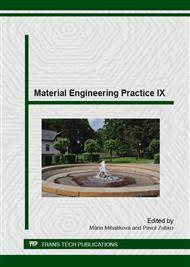[1]
H. Huh, J. H. Lim, et al. High speed tensile test of steel for the stress-strain curve at the intermediate strain rate, International Juornal of Automotive Technology 10 2 (2009) 195-204.
DOI: 10.1007/s12239-009-0023-3
Google Scholar
[2]
M. Német, M. Mihaliková, The effect of strain rate on the mechanical properties of automotive steel sheets, Acta Polytechnica 53 4 (2013) 384-387.
DOI: 10.14311/1839
Google Scholar
[3]
B. Hadzipasic, A. Malina, Š. Nižnik, Influence of microstructure on hydrogen diffusion and impedance of IF-steel, Kovové materiály, 50 5 (2012) 345-50.
DOI: 10.4149/km_2012_5_345
Google Scholar
[4]
M. Mihaliková, M. Német, Increments of plastic strain and hardness HV10 of automotive steel sheets, Metalurgija 51 2 (2012) 449-452.
Google Scholar
[5]
E. Čižmárová, M. Mihaliková, M. Német, Efect of changes deformation rate on mechanical properties microalloyed steels, Chemické listy 105 16 (2011) 546-548.
Google Scholar
[6]
M. Mihaliková, M. Német, The hardness HV1 analysis of automotive steels sheets after a plastic deformation, Acta Metallurgica Slovaca 17 1 (2011) 26-31.
Google Scholar
[7]
J. Slota, M. Jurčišin, E. Spišák, Experimental and numerical analysis of local mechanical properties of drawn part, Key Engineering Materials 586 (2014) 245-248.
DOI: 10.4028/www.scientific.net/kem.586.245
Google Scholar
[8]
M. Mihaliková, Research of strain distribution and strain rate change in the fracture surroundings by the videoextensometric methode, Metalurgija 49 3 (2010) 161-164.
Google Scholar
[9]
M. Buršák, I. Mamuzič, M. Mihaliková, Influence of blasting on mechanical properties of steel sheet, Metalurgija 43 2 (2004) 101-105.
Google Scholar
[10]
E. Evin, M. Tomáš, et al. The deformation properties of high strength steel sheets for auto-body components, Procedia Engineering 69 (2014) 758-767.
DOI: 10.1016/j.proeng.2014.03.052
Google Scholar
[11]
W. Moćko, Z. Kowalewski, Application of FEM in the assessment of phenomena associated with dynamic investigations on a miniaturised DICT testing stand, Kovové materiály 51 1 (2013) 71-82.
DOI: 10.4149/km_2013_1_71
Google Scholar
[12]
E. Evin, M. Tomáš, J. Výboch, Prediction of local limit deformations of steel sheets depending on deformation scheme, Chemické listy, 106 3 (2012) 401-404.
Google Scholar
[13]
E. Kormaníková, K. Kotrasová, Finite element analysis of damage modeling of fiber reinforced laminate plate, Applied Mechanics and Materials, 617 (2014 ) 247-250.
DOI: 10.4028/www.scientific.net/amm.617.247
Google Scholar


